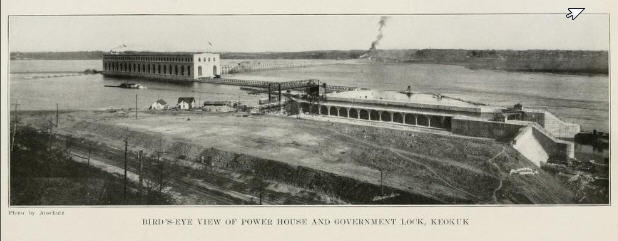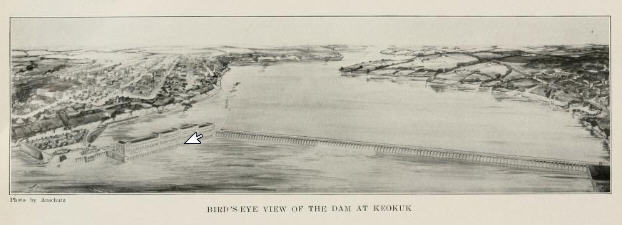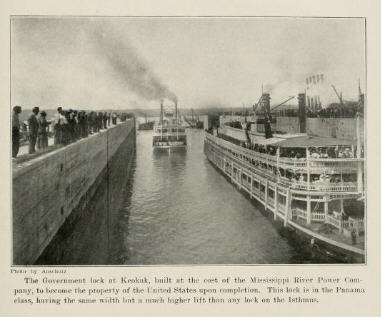One of the greatest
engineering feats of modern times was the construction
of a great dam across the Mississippi River at the
foot of the Des Moines Rapids, in front of the City of
Keokuk. Soon after the first white men settled in
Southeastern Iowa, the subject of utilizing the rapids
for the development of water power began to be
discussed. While Lieut. Robert E. Lee was stationed at
old Fort Des Moines he made a report to the war
department, in which he suggested the possibility of
turning the immense energy of the rapids to some
account for the advancement of civilization, and at
the same time improving the navigation of the
Mississippi. No action was taken by the Government at
the time, but in the light of subsequent developments
it reads almost like a prophecy.
People who understood nothing of the practical side of
engineering could not recognize that such a thing was
possible as the harnessing of the rapids and the
development of water power for the use of man. The few
who did understand realized that the undertaking was
hardly practicable then, because the population of the
Mississippi Valley was too sparse to justify the vast
expenditure of labor and capital to carry it out.
Nevertheless, these few were not willing to abandon
the idea altogether and in 1836, while Iowa was still
a part of Wisconsin Territory, a company of local men
and New York financiers was organized to consider the
feasibility of developing a water power from the
rapids.
The first actual effort to utilize the force of the
rapids for industrial purposes was made in 1842, when
a man named Gates constructed a wing dam and erected a
grist mill on Waggoner's Point, on the Illinois side
of the river, a short distance above the eastern
terminus of the present dam. A great ice jam carried
away Mr. Gates' wing dam, but with a persistence
worthy of emulation he constructed another and
continued to operate his mill with power furnished by
the Mississippi. Both his dams were very small and
utilized but a very small portion of the power that
could have been, and has been since generated.
In 1843 Joseph Smith, the Mormon prophet of Nauvoo,
Illinois, had the council of that municipality pass an
ordinance giving him a franchise to build a dam from
the Nauvoo shore to an island in the river to generate
power. But before his project could be carried out
Smith met his death while a prisoner in Carthage jail
and the Mormons left for Utah.
Five years after Smith's franchise was granted the
people of Keokuk became interested in the subject and
some of the leading citizens of that city organized a
company to develop the power. Although the efforts of
that company resulted in nothing toward the actual
building of a dam, the public became inoculated with
the germ and from that time there have always been a
few optimistic individuals ready to predict that some
time, in some way, the power of the rapids would be
brought under control and rendered available for
industrial purposes. Another company was organized in
1865 and kept up the hammering process, trying to
interest capitalists, never for a moment doubting that
some day their dream would become a reality.
In 1868 the United States Government began the
construction of a canal along the Iowa shore through
the rapids, for the purpose of improving the
navigation of the river. It was completed and opened
for boats in 1877. In this canal there were three
locks — the upper one at Galland, the middle lock,
near Sandusky, and the lower lock, at the foot of the
rapids. The cost of the canal was $4,500,000 and about
three millions more were expended on the dry dock and
appurtenances.
Although the Government work was not intended to
develop the water power of the rapids, it served as a
stimulus to interested parties to take some definite
action toward that end. Consequently, in 1871, while
the Government canal was under construction, two
Keokuk men employed an engineer to make a survey for a
dam at their own personal expense. Their idea was to
construct a large wing dam, but the proposition did
not meet with the approval of the engineer, who
advised them that such an undertaking would be likely
to prove unprofitable. The press took up the subject
at that time, however, and awakened general interest
in the subject.

Bird's Eye View of Power House and Government Rock

Bird's Eye View of Keokuk Dam
In 1893 came the first suggestion that electricity
might be used to transmit the power generated by water
wheels, but the electric motor was then in an
embryonic state, and until the motor was brought to a
higher state of perfection its use was not to be
considered. Thus matters stood until July, 1899, when
C. P. Birge called a meeting of some twenty-five
citizens of Keokuk and Hamilton, Illinois — just
across the river from Keokuk — to make one more effort
to brins? about the construction of a dam. This
meeting was really the beginning of the Mississippi
River Power Company. In April, 1900, the Keokuk &
Hamilton Power Company was incorporated under the laws
of Illinois with A. E. Johnstone, president; William
Logan and C. P. Dadant, vice president; R. R. Wallace,
secretary and treasurer; Wells M. Irwin and D. J.
Ayers, of Keokuk, and S. R. Parker, of Hamilton,
directors.
This company obtained a charter from the Federal
Government in February, 1901, for the construction of
a wing dam on the Illinois side, and Lyman E. Cooley,
a hydraulic engineer of Chicago, was employed to make
the survey and specifications. Mr. Cooley pronounced a
wing dam impracticable and the company was forced to
abandon its original intention.
In April, 1904, Congressman B. F. Marsh introduced a
bill to grant the Keokuk & Hamilton Water Power
Company the right to build a dam across the
Mississippi River at the foot of the rapids. The bill
passed both houses of Congress at the next session and
was approved by the President on February 9, 1905. In
April, 1905, the stock and franchise of the company
was assigned to and vested in a committee consisting
of John H. Irwin, A. E. Johnstone, William Logan and
C. P. Dadant, with full power to make contracts and
transact all other business pertaining to the dam
project. Concerning this company and its committee,
one of the Keokuk papers said:
"It must not be forgotten for a moment that this
corporation was a quasi-public, quasi-governmental
corporation, outside of, and yet a part of the
political organization of the State of Iowa, as is the
public school system for instance. Its stationery
should have borne the subtitle, 'The Public,
Incorporated.' While it had a trifle of $2,500 of paid
up capital, it handled many times that amount of money
as a public trust, a considerable amount coming to its
treasurer from the municipal treasuries of Keokuk and
Hamilton. There was never in the history of the world
anything like that water power promoting corporation.
It was frankly organized for promotion purposes, as
the representative of the citizenship
hereabouts.
"It operated practically by unanimous consent. Its
officers were men of the two cities possessing the
full confidence of the masses of the people. It did
things to the municipalities that have never been
paralleled and that are among the highest triumphs of
a dominant democracy. It said it needed money at one
time to pay for surveys and other legitimate promotion
work — and the city councils of Keokuk and Hamilton
promptly voted it an appropriation of public money. Of
course this was widely extra-legal ; far from any
concealment, the greatest publicity was given to the
intended action before it was taken; every citizen
suspected of opposition was asked personally, and by
newspaper notice everybody else was practically
invited to stop the action, if they chose, by a very
simple injunctive process. Not a man could be found in
the two towns who had any objection. Every citizen
considered it his own movement, this water power
development movement. It was a movement of the entire
mass acting as a unit."
The Keokuk & Hamilton Water Power Company, through
its committee, prepared a circular pamphlet or
prospectus giving some data concerning the Mississippi
River at the rapids and a statement of their aims and
needs, chief of which was the capital to build a dam
and a competent engineer to take charge of the
undertaking. One of these pamphlets fell into the
hands of Hugh L. Cooper, an engineer who had already
made a world-wide reputation by his achievements in
Jamaica, Brazil, at Niagara Falls and McCall's Ferry,
Pennsylvania. Mr. Cooper came to Keokuk, looked over
the field, and started out in quest of the necessary
capital. He exhausted his private means, and when it
looked as though failure was inevitable Stone &
Webster, of Boston, came to the rescue with a
proposition to finance the undertaking. Of the capital
stock, 35 per cent of it was raised or subscribed in
the United States and the remaining 65 per cent came
from foreign countries, England, France, Germany,
Belgium and Canada being the principal contributors
toward the consummation of a project that had been
hoped for for more than half a century.
On September 15, 1905, the committee in charge of the
affairs of the Keokuk & Hamilton Water Power
Company entered into a contract with Mr. Cooper, by
which the stock and franchise of the company were
turned over to his syndicate, on the condition that
the dam and power plant were to be completed by
February 10, 1915.
A survey of the site of the proposed dam and its
environments disclosed the fact that many acres of the
low lying lands above the dam would be overflowed by
its construction. As rapidly as possible the
representatives of the company visited the owners of
these lands for the purpose of purchasing overflow
rights, and in some instances the lands were bought
outright. Altogether, about thirteen hundred land
owners were dealt with in this way, and it is worthy
of comment that every one surrendered his land or the
right to overflow it without law suits or other
vexatious delays, something unusual where a great
corporation desires private property for some gigantic
enterprise. Fourteen miles of the tracks of the
Chicago, Burlington & Quincy Railroad, that
formerly ran close to the old river bank, were raised
above the new water level, and this also was
accomplished without litigation. At Montrose it was
necessary to remove a cemetery and the company had to
buy a portion of that town, as well as considerable
property at Sandusky and Galland. At Fort Madison it
was discovered that the back-water from the dam would
affect the sewer system and considerable work was done
to overcome this difficulty. Yet all these obstacles
were overcome without serious delays, because
everybody believed in the dam and everybody wanted to
see it built.
In addition to the acquisition of lands or overflow
rights and the changes in the towns above mentioned,
the war department imposed several conditions to which
the plans must conform. Every detail of the
construction work had to be submitted to the secretary
of war and receive his indorsement, really through the
chief of engineers of the army. The building of the
dam made the old Government canal an obsolete
institution. The company was therefore required to
build a lock and dry dock and provide means for their
perpetual operation. Upon the completion of the lock
and dry dock, they were to become the property of the
United States without cost to the Government. Major
Keller, who was in charge for the Government,
afterward stated that the company not only complied
with all the conditions imposed by the war department,
but also did a number of things not included in the
conditions, the cost of which he estimated at
$200,000.
As soon as all these preliminary arrangements could be
completed, work was commenced on the dam itself. To
describe all the details of that work, such as the
building of the huge cofferdam to keep out the water,
the excavating into the bed rock for an anchorage for
the concrete work, the conflicts with storms and
floods to protect the dam during the process of
construction, would require a volume. And while it
might prove interesting to the reader, it is not
considered necessary to give such an account
here.
The length of the dam, including the abutments at each
end, is 4,649 feet, or nearly nine-tenths of a mile.
At the base it is forty- two feet in thickness and at
the top, twenty-nine feet. It is composed of 119
arched spans, so molded together that it is virtually
one solid piece of concrete, which extends downward
about five feet into the bedrock, to which it is
securely anchored. Each of the 119 arches is provided
with a gate of steel truss framework faced with a
sheet of the same metal. These gates can be raised or
lowered and thus keep the water above the dam at a
fixed and uniform level. In times of very high water
they are all left open; in stages of unusually low
water all can be kept closed. By this system a
constant stage of water is maintained above the dam
and the pressure against the whole structure
regulated.
The power house is 1,718 feet long, 132 feet 10 inches
wide, and 177 feet 6 inches high, measuring from the
lowest point in the tail race to the roof. The
foundation begins in the bedrock, about twenty-five
feet below the natural bottom of the river, for the
purpose of gaining more fall. The substructure is one
solid mass of concrete, cast in forms so as to form
the necessary passages and chambers through which
passes the water that moves the great turbines.
Reinforced concrete was used in building the walls of
the superstructure, or power house proper, in which
are the generators, etc.
Between the power house and the Iowa shore is the
lock, which is 1 10 feet wide, 400 feet long, with a
lift of 40 feet. The walls of this lock are 52 feet
high and vary in thickness from 8 to 33 feet. Directly
north of the lock and next to the Iowa shore is the
dry dock, 150 by 463 feet.
On the last day of May, 1913, the last concrete in the
dam was placed in position. As soon as it set the
water above was gradually raised and flowed through
the spillways for the first time on June 3, 1913. Nine
days later the lock was put into commission by the
passage at one time of two of the largest steamboats
on the Upper Mississippi. On July 1, 1913, electric
current was delivered to St. Louis. The great power
plant was in operation and the dream of years had
become a reality. A formal celebration of the great
achievement was held at Keokuk on August 25, 26, 27
and 28, 19 1 3, the second day of the proceedings
being the day when the great dam was dedicated to the
use of mankind. Governor Clarke, of Iowa, and Governor
Dunne, of Illinois, were prominent participants in the
exercises, and thousands of visitors came to visit and
inspect the work.

The Government lock at Keokuk, built at
the cost of the
Mississippi River Power Company, to become the
property
of the United States upon completion. This lock is
in the Panama class, having the same width but a
much
higher lift than any lock on the Isthmus. Photo
by Anschutz.
Soon after work was commenced the plant was
placed under the management of the Stone & Webster
Management Association, which manages more than fifty
public utilities in all parts of the United States,
and some of their best trained and most experienced
men were sent to Keokuk to look after the service.
Transmission lines have been built to Fort Madison and
Burlington, Iowa; Dallas City, Nauvoo, Warsaw, Quincy
and Alton, Illinois; Hannibal and St. Louis, Missouri,
and light and power are also furnished to the cities
of Keokuk and Hamilton.
The large body of water held in check by the dam,
extending up the Mississippi to the City of
Burlington, has been named Lake Cooper, in honor of
the engineer who designed and constructed the dam.
From the low islands in the river and the partly
submerged woodlands along the shores the timber has
been removed by the power company, so that the trees,
after being killed by the water constantlv standing
around their roots, may not be washed into the stream
and become a menace to navigation. By the raising of
the water level several miles of wagon roads along the
river banks were overflowed. To overcome this
condition of affairs, the company offered to donate a
right-of-way through its property, use its engineers
and equipment and give $75,000 toward the cost of
constructing boulevards to Montrose, Iowa, and Nauvoo,
Illinois. These improvements were finally completed at
a cost of $375,000.
Changing the water level also submerged several
historic points in Lee County. Foremost among these is
probably the huge bowlder known as "Mechanic's Rock,"
from the fact that the steamboat Mechanic was wrecked
by striking it in 1830. This rock is situated at the
head of the rapids, about a mile below the Town of
Montrose and near the Iowa shore. In times of low
water it stood above the surface and was one of the
landmarks used by pilots on the Mississippi. When it
was covered with water boats could take the open
channel without danger. The steamer Illinois was also
wrecked upon this rock on April 20, 1842.
Lemoliese, the French trader who located where
Sandusky now stands in 1820, was buried near the bank
of the river and his grave has been covered by water
since the construction of the dam. Part of the old
Tesson land grant has also been submerged.
Source: History
of
Lee County, Iowa, by Dr. S. W. Moorhead and
Nelson C. Roberts, 1914
|
|



